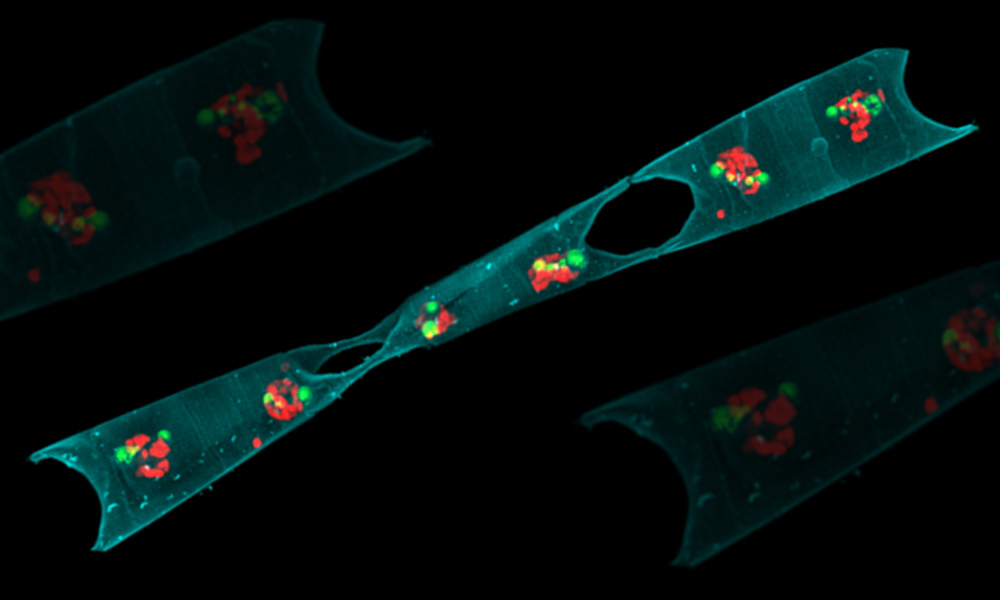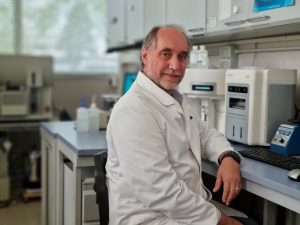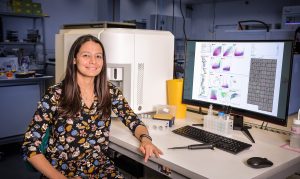EMBL's flow cytometry facilities support a variety of life sciences research, with new leaders planning to enhance their offerings

Throughout the planet's oceans reside a modest group of organisms with a fairly monumental task.
These special bacteria, known as diazotrophs, convert atmospheric nitrogen into the biologically usable form that is essential for all organisms to live. As oceans warm and their pH balances change, scientists want to know more about these small organisms that make such a big contribution to our survival as a species. In many instances, the first step of these investigations is done with a flow cytometer.
That is certainly the case for Hugo Berthelot, a postdoc in the Pepperkok Team who is studying the diverse shapes of diazotrophs. He is interested in whether their shape affects how well diazotrophs convert nitrogen or their capacity to withstand climate change in their habitat.
Berthelot is also one of an increasing number of EMBL researchers whose work at the EMBL flow cytometry facilities goes beyond simply analysing and sorting human cells to reflect a broadening One Health perspective.
"We're just at the beginning of understanding the diversity within these cells," Berthelot said. He uses the flow cytometer to sort cells before subjecting them to genomic and other omics analyses - to further understand, for example, where in the cells photosynthesis happens.
The 'fluidity' of a flow cytometer
Cytometers and cell sorters use laser beams to analyse, sort, and separate cells or organisms flowing in a stable stream of fluid.
"Imagine shining a beam of light through a stream of water as droplets pass by," said Diana Ordonez, the head of the Flow Cytometry Core Facility at EMBL Heidelberg.
"The instrument generates droplets containing particles or cells that are excited by the laser beams, measures the emitted light, and then deflects the drop carrying a particle of interest out of the stream and into a collection tube or plate," she explained. "That's what makes it possible to separate out a given particle."
For instance, scientists could separate a population of interest, such as T cells, from a blood sample containing several types of immune cells and use it for downstream analysis.

Ordonez and Gerald Pfister, the head of the Flow Cytometry Facility in EMBL Rome's Epigenetics and Neurobiology Unit, agree that if a sample can be suspended in a liquid, a flow cytometer can analyse it.
"The most classic example is when you have blood test; cell populations in your blood are identified and quantified using a flow cytometer," Pfister said. "But flow cytometers are used for looking at a variety of things - algae cells, ciliates (protozoans with hairy edges known as cilia), bacteria in water samples, even in food quality control systems to assess bacteria in milk or yeast cells in beer."
Flow cytometry and building bridges
Ordonez, who has worked at EMBL Heidelberg's flow cytometry facility since 2015, took the helm in February.
Pfister came to EMBL Rome's facility in June after more than 20 years in different roles in industry and academia around the world, from Austria and Brazil to Belgium to Qatar. In Qatar, he spearheaded the development of a flow cytometer core lab. In all his roles, he has been mindful of end-user service as well as public outreach.
"My hope is to be actively involved in projects here," Pfister said. "At this point, I have a lot of tips and ideas, so I can really contribute as people plan projects."
Ordonez also has a long history with flow cytometry. Before coming to EMBL, she used flow cytometry at the Centre d'immunologie de Marseille-Luminy to study a variety of immune cells - T cells, B cells, dendritic cells, natural killer cells, monocytes, and progenitor cells - in mice. Her goal was to establish a reliable model to analyse the role that a specific kind of white blood cell has in the immune response.

She then moved to EMBL, principally because - like Pfister - she enjoys training, advising, and assisting other researchers in flow cytometry. It's this attitude that is a guiding force for both scientists as they share their plans for the future.
Looking ahead
As EMBL embarks on its next five-year research programme, EMBL's flow cytometry facilities are looking at ways to adapt to an increasingly multidisciplinary environment, and one that will begin exploring living systems in their natural context.
"I have a PhD in freshwater biology, so I am looking forward to this challenge," Pfister said. "This opens up opportunities to collaborate with different research teams, not just on biomedicine or related to medical conditions."
The two EMBL facilities have flow cytometers and cell sorters with slightly different capabilities. Ordonez and Pfister perform most of the flow cytometry work themselves, advising individual researchers on their given projects, developing optimal flow applications, and troubleshooting their experimental setup.
Training helps to expand the pool of hands-on users and allows others to learn how flow cytometry can be used in their own varied research projects. From data analysis workshops to practical courses in flow cytometry and cell sorting presented in cooperation with the German Cancer Research Center (DFKZ), EMBL's flow cytometry training is offered to the international science community and is always in high demand. It's why Ordonez is looking for creative ways to expand it.
Teamwork makes the flow cytometry work…better
Collaborations with other EMBL core facilities have been part of that creative management approach in the past, so will likely play a role in the future. Ordonez is quick to note the convenient location of the Genomics Core Facility (GeneCore), which is right across the hall doing gene sequencing - a logical follow-up to flow cytometry for epigenetics and genetics researchers.
Over the years, the challenging scientific needs of EMBL's flow cytometry customers have made these facilities a good testbed for piloting new technology. In fact, Berthelot's research benefits from exactly this kind of 'beta testing' of a new instrument. He is using detectors to create rapid-fire images and use them in addition to conventional flow cytometry parameters to analyse and separate particles of interest. The images help Berthelot to more easily identify and understand the complexity of organisms present in his samples.
Ordonez and Pfister agree that the two facilities will increasingly find ways to collaborate to enhance their offerings and position themselves better at EMBL. "I started out studying microbiology because I had this dream to do oil-spill remediation," Ordonez recounted. "Though I ended up studying immunology, we all need to do something for this planet. It just has to be done. All these resources and bright minds here at EMBL can make a difference."






